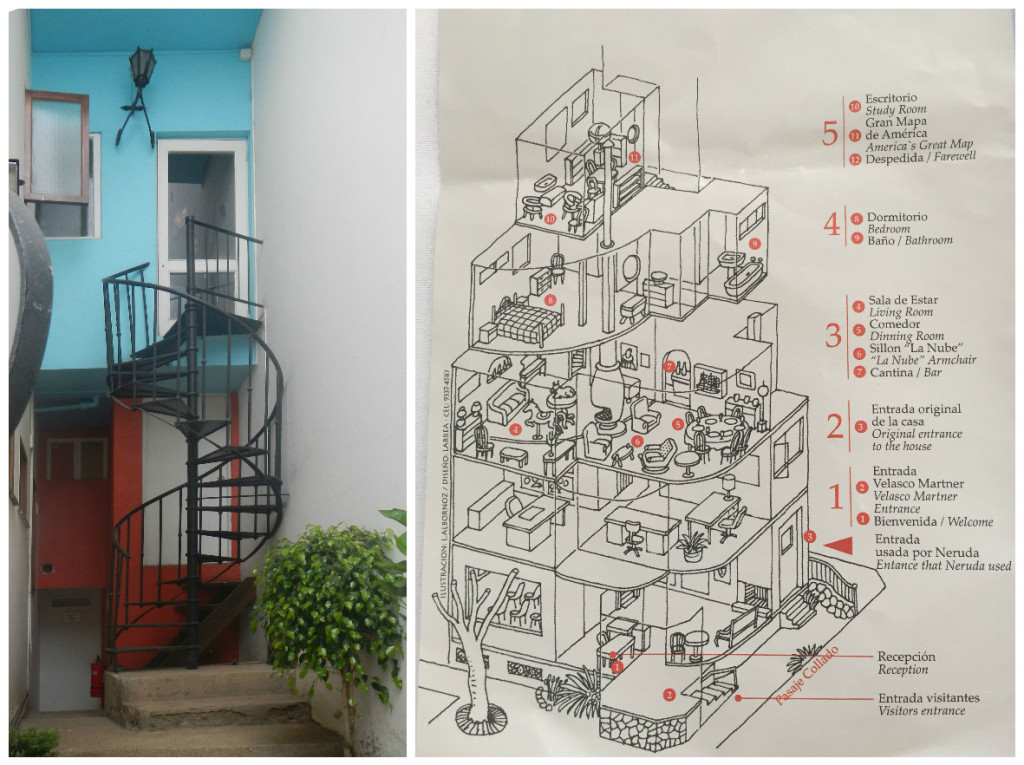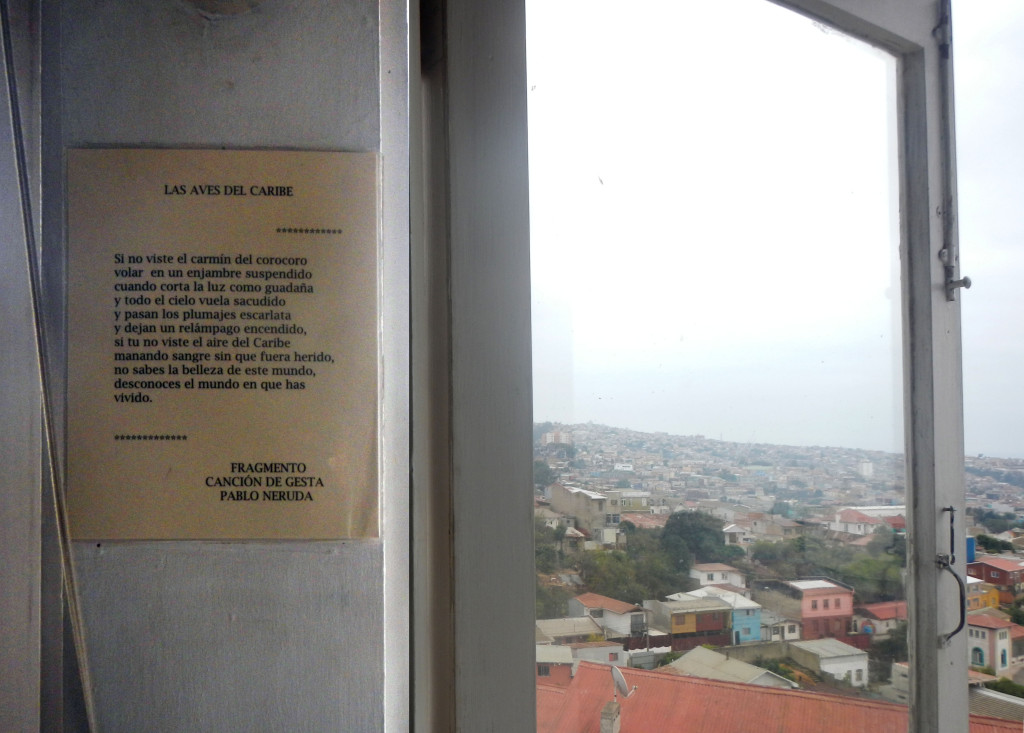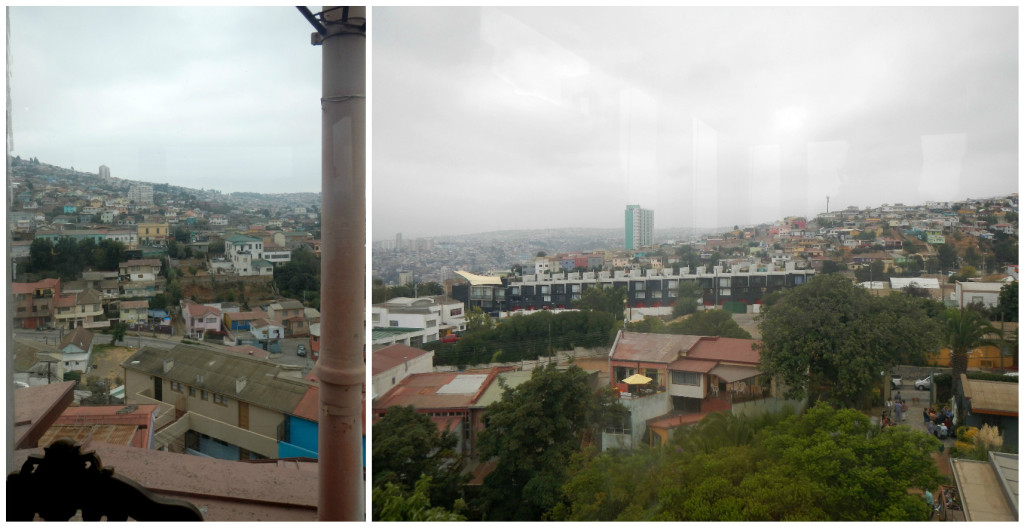As a Spanish Literature student, I’m familiar with Pablo Neruda’s name and a brief smattering of his poetry—particularly the odes he wrote to everyday objects (some of my favorites in the entire selection of Latin American poetry I’d read throughout college)—so I was pretty excited to visit La Sebastiana. I figured I would learn a bit more about Neruda by visiting his house-turned-museum, but did not expect the house would be so eclecticly entertaining.
La Sebastiana, named after the original constructor/owner Sebastián Collado, who died before it could be completed, is comprised of five stunning and quirky floors filled to the brim with Neruda himself through his collections of things. It took Neruda another three years to finish construction of the house. The compelling audio tour (available in English, Spanish, French, and Portuguese) used the same devices as The Museum of Memory and Human Rights, and painted a narrative through various objects, furniture items, windows, doors, and other details.
We were told the only rule was no photographs, unless it was to photograph the view from a window on the five floors. Sadly, this meant capturing the vibrant personality of Neruda’s Valparaíso home was even more impossible. But at least I can share a few of the spectacular views, which were slightly different on each floor. The right photo at the very top of the post shows the view looking out to the left from the living room window (the one straight ahead from the door).

Neruda’s guests originally had to walk up this spiral staircase to enter. Once inside, they might be greeted by Neruda and would sit on a bench opposite to the door, in a cavity under the staircase, underneath a painting of Jose Miguel Carrera just before his death (a leader in the Chilean War of Independence). Neruda often discussed and lamented what it must have been like to be part of the Carrera family sitting here with guests, said the audioguide. It must have been hypnotic, having a deep discussion with Neruda while being surrounded by wallpaper with thin vertical pinkish and white stripes.
You must then leave the entrance to go up a staircase through a ridiculously narrow doorway, flanked with European-style sculptures, painted in gold. How narrow, you ask? Jon tried walking through the doorway straight-on, but his shoulders couldn’t fit. That’s not the most narrow, but it’s pretty narrow.
On the left as you walk up the stairs, you can see a huge vertical mosaic made of stones which portrayed an old map of Patagonia. Neruda commissioned a good friend of his to create this and a stone fireplace in the living room, as well as other pieces in his two other homes.

Windows along hallways and staircases were often made of stained glass, or designed to look like windows on a ship. The staircases were just the width of a regular doorway, no more, and the walls displayed other things Neruda collected over the years.
Entering the living room, you walk through a different, very wide door, rounded on the top, with a life-sized human hand knocker, in bronze. You’ll find yourself on a circular platform and opposite to you sits a wooden pony, originally used for a carousel. Neruda placed it on the circular platform as if it were still spinning on a carousel, for all of time.
Neruda bought a painting of a woman (was it a Queen?) who wore a large ruff (tall white neck cuff with ridges/fluff) for his living room. Thinking the woman might be lonely, he then bought a painting of a man who also wore a ruff to keep her company. He placed them opposite each other so they could look into each others eyes.
Underneath the ruff-wearing-woman’s painting, sits a beautiful chest where Neruda would keep his finest whiskies. A small wall with a fireplace both connected the round platform to the rest of the room. Neruda designed it himself, and I believe the same friend who created the stone mural helped him realize it.
The living room has a panoramic view of Valparaíso which he could enjoy while sitting on his favorite armchair, “La Nube” or “The Cloud.” Drops of his signature green ink decorate his footstool, and an embalmed bright pink bird hangs from the ceiling (one of Neruda’s prized souvenirs from Venezuela). It sorta looks like a mini flamingo, and Neruda called it “el carmin del corocoro” in his poetry.
 On the left of the round platform was the dining area. He never ate alone, so here we saw his table, set for 6, with colored/stemmed water glasses (Neruda said water tasted better out of a red or green glass), wine glasses (white ceramic, stout and pear shaped), and fine china, often from England. In the center of the table, he had a ceramic cow that had a lid, sorta like a cookie jar, from which he liked to serve punch.
On the left of the round platform was the dining area. He never ate alone, so here we saw his table, set for 6, with colored/stemmed water glasses (Neruda said water tasted better out of a red or green glass), wine glasses (white ceramic, stout and pear shaped), and fine china, often from England. In the center of the table, he had a ceramic cow that had a lid, sorta like a cookie jar, from which he liked to serve punch.
He loved entertaining, and would think of elaborate menus with each specific guest in mind. During his life as a diplomat, he’d bring with him cases of Chilean wine abroad to share with his special guests while entertaining. He would dress up in elaborate costumes, often changing it many times during a party.
Above the dining area sits a large 3-D-ish illustration of daily life in an old rural town complete with a working clock, music box (Neruda was known for collecting music boxes), and other moving parts. I say 3-D-ish, because parts of the illustration had been raised, like a woman’s arm washing, or someone’s hand waving, while the rest was on the same base plane. As the clock would tick, the raised parts of the illustration would fiddle around, moving on their own.
Behind the living room was a brilliant bar. The room suddenly became much more vibrant in color. Neruda was the only one allowed behind the bar. He particularly loved to make a drink called the “Coquetelón,” comprised of cognac, champagne, orange juice and cointreau. He collected drinking glasses and even had a set from Czar Nikolas on display.
Neruda called the bathroom in the bar “the bathroom for the brave,” or something to that effect, because its door was an ornate pastel pink metal grate allowing all in the room a view of the toilet and sink. It wasn’t the house’s only bathroom of course.
The bathroom on the 4th floor just outside Neruda’s bedroom has a beautiful view of Valparaíso. This bathroom only had the essentials, no mirror or boudoir, or as he claimed that his wife Matilde took too long when using it.

Neruda’s bedroom, also on the 4th floor, had more windows still surrounding the bed. He’d often wake up and listen to the radio to keep up with current events. The small dressers by the bed were originally on ships (Neruda loved boats/all nautical-ness), and you could see his slippers sitting at the bottom of one of them. The closets, mostly for Matilde (some of her shoes were still inside), had doors Neruda collected from Asia. There was a detailed 3-D relief in gold depicting a Chinese fable of when a dog had eaten the moon (one of Jon’s favorite objects in the house).
The 5th and final floor was Neruda’s study, where he routinely worked for hours every day. He built it to mimic a ship because, though he was afraid of going out on the water, he considered himself a sailor on land. He installed a bigger-than-life-sized portrait of Walt Whitman here (when a worker asked him if that was his father, he replied, “Yes, in poetry”). On his desk, the museum placed an original copy of the poem “La Sebastiana,” a poem Neruda wrote about this house and read to guests who attended the home’s inaugural party, along with translations.
Neruda had an elaborate blue and white ceramic sink from a ship installed in the study, opposite his desk. It had never been connected to plumbing, however. There was also a wall-sized early map of the Americas, complete with a description of Chile. The author of the map had gotten both the map and the history so terribly wrong, confusing the origin of the country name “Chile” with the English word “chilly,” claiming that the country could be so terribly cold (thus the name), people could die suddenly from the weather. It also had an island called “California” off the coast of North America, spanning the entire height of the continent.


Neruda considered his house a collection of toys. He preferred it this way, as it allowed him to wake up in the morning and play until night. He surrounded himself with inspiration, from items that reminded him of, or were created by, his favorite people, to such singular and eccentric collectors items. I’m hoping that one day our house can be as fun and inspiring too.
Only a certain number of people are allowed in at any one time, so it’s possible you’ll have to wait before going in. It costs 6000 CLP to enter, and in my opinion, the visit is worth much more. We’d met a couple the night before who mentioned hiking up for the view, but because they didn’t want to pay the entrance, had forgone the visit to La Sebastiana. What a shame, what a shame.

Just had a wonderful personal guided tour 🙂
It’s my kind of home except for the bathroom in the bar (view) :0
🙂
It’s a piece of art in itself, with beautiful views. Hah, yes-I wonder how often that bathroom got used!
What a rich time spent! Love all the views, in the photos and the mental images you helped construct! I liked his use of red or green vessels to serve water in.
Thanks! It’s been my favorite part of Chile so far, I can’t wait to see his house in Santiago next =D
Thank you for taking me in this wonderful journey with you. It makes me feel like I was there
I am looking forward to visiting Chile in the future
I hope you do! The people are so friendly here and there’s an air of political-ness in the culture (in a great way!) that I think you’d love (people exercising their rights, and voicing their opinions).
Wow!!! Makes me want to visit!!
It’s well worth the trip! Neruda’s got 2 other houses in the area and they are all said to be spectacular in their own ways =)
Great description of the house! I felt like I was walking with you!
Thanks! It really is something else. Everywhere you look there’s another cool object or interesting detail!